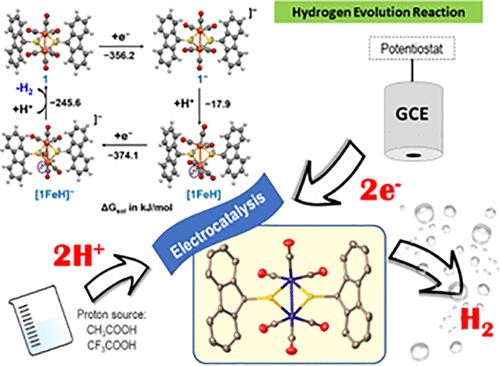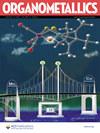Design of Rigidified μ-(9-Fluorenethiolate) {FeFe} Hydrogen Evolving Catalysts
IF 2.5
3区 化学
Q2 CHEMISTRY, INORGANIC & NUCLEAR
引用次数: 0
Abstract
The hexacarbonyl diiron complex [Fe2(μ-9-fluorenethiol)2(CO)6] (1) has been synthesized and characterized by various spectroscopic techniques as well as quantum chemical calculations. The molecular structure for complex 1 was determined by single-crystal X-ray diffraction and was supported by density functional theory (DFT) calculations. Complex 1 crystallized in the tetragonal P4̅21m crystal system with both fluorene moieties anti to each other. According to a QM conformational search, this corresponds to the lowest energy conformer. The complex displayed electrocatalytic activity for proton reduction in the presence of organic acids (acetic acid and trifluoroacetic acid), which was investigated by cyclic voltammetric (CV) and controlled-potential coulometric (CPC) experiments and calculations. Bulk electrolysis of complex 1 in the presence of an acid resulted in significant hydrogen evolution. DFT calculations demonstrated that complex 1 undergoes a one-electron metal-based reduction with a calculated redox potential in excellent agreement with experiment (at a low potential of −1.32 V), while a two-electron reduction occurs at a more negative potential of −1.70 V. Due to the rigidity of the μ-bridging 9-fluorenethiolates and structural integrity of 1 during reduction events, a two-electron-reduction mechanism followed by protonation of a terminal iron hydride species appears feasible.

刚性μ-(9-芴硫酸盐){铁-铁}催化剂的设计氢蒸发催化剂
我们合成了六羰基二铁络合物 [Fe2(μ-9-芴硫醇)2(CO)6](1),并通过各种光谱技术和量子化学计算对其进行了表征。复合物 1 的分子结构是通过单晶 X 射线衍射确定的,并得到了密度泛函理论(DFT)计算的支持。复合物 1 在 P4̅21m四方晶系中结晶,两个芴分子相互反向。根据 QM 构象搜索,这相当于能量最低的构象。该复合物在有机酸(醋酸和三氟乙酸)存在下显示出质子还原的电催化活性,这一点通过循环伏安(CV)和受控电位库仑计(CPC)实验和计算进行了研究。复合物 1 在酸存在下的大量电解产生了大量的氢演化。DFT 计算表明,络合物 1 会发生单电子金属基还原反应,计算出的氧化还原电位与实验结果非常吻合(在 -1.32 V 的低电位下),而在 -1.70 V 的较负电位下会发生双电子还原反应。在还原过程中,由于 9-芴硫醇的 μ 桥和 1 的结构完整性,双电子还原机制似乎是可行的,随后是末端铁氢化物的质子化。
本文章由计算机程序翻译,如有差异,请以英文原文为准。
求助全文
约1分钟内获得全文
求助全文
来源期刊

Organometallics
化学-无机化学与核化学
CiteScore
5.60
自引率
7.10%
发文量
382
审稿时长
1.7 months
期刊介绍:
Organometallics is the flagship journal of organometallic chemistry and records progress in one of the most active fields of science, bridging organic and inorganic chemistry. The journal publishes Articles, Communications, Reviews, and Tutorials (instructional overviews) that depict research on the synthesis, structure, bonding, chemical reactivity, and reaction mechanisms for a variety of applications, including catalyst design and catalytic processes; main-group, transition-metal, and lanthanide and actinide metal chemistry; synthetic aspects of polymer science and materials science; and bioorganometallic chemistry.
 求助内容:
求助内容: 应助结果提醒方式:
应助结果提醒方式:


